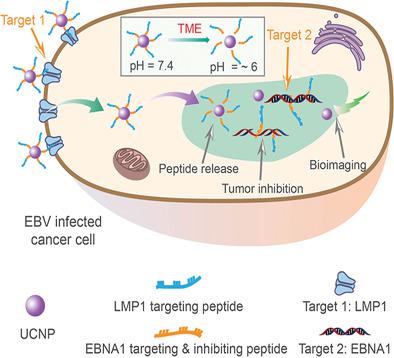Our official English website, www.x-mol.net, welcomes your
feedback! (Note: you will need to create a separate account there.)
Dual‐Targeting Peptide‐Guided Approach for Precision Delivery and Cancer Monitoring by Using a Safe Upconversion Nanoplatform
Advanced Science ( IF 14.3 ) Pub Date : 2021-01-06 , DOI: 10.1002/advs.202002919 Shuai Zha 1 , Ho-Fai Chau 1 , Wai Yin Chau 2 , Lai Sheung Chan 1 , Jun Lin 3 , Kwok Wai Lo 4 , William Chi-Shing Cho 5 , Yim Ling Yip 6 , Sai Wah Tsao 6 , Paul J Farrell 7 , Liang Feng 8 , Jin Ming Di 9 , Ga-Lai Law 8 , Hong Lok Lung 1 , Ka-Leung Wong 1
Advanced Science ( IF 14.3 ) Pub Date : 2021-01-06 , DOI: 10.1002/advs.202002919 Shuai Zha 1 , Ho-Fai Chau 1 , Wai Yin Chau 2 , Lai Sheung Chan 1 , Jun Lin 3 , Kwok Wai Lo 4 , William Chi-Shing Cho 5 , Yim Ling Yip 6 , Sai Wah Tsao 6 , Paul J Farrell 7 , Liang Feng 8 , Jin Ming Di 9 , Ga-Lai Law 8 , Hong Lok Lung 1 , Ka-Leung Wong 1
Affiliation

|
Using Epstein‐Barr virus (EBV)‐induced cancer cells and HeLa cells as a comparative study model, a novel and safe dual‐EBV‐oncoproteins‐targeting pH‐responsive peptide engineering, coating, and guiding approach to achieve precision targeting and treatment strategy against EBV‐associated cancers is introduced. Individual functional peptide sequences that specifically bind to two overexpressed EBV‐specific oncoproteins, EBNA1 (a latent cellular protein) and LMP1 (a transmembrane protein), are engineered in three different ways and incorporated with a pH‐sensitive tumor microenvironment (TME)‐cleavable linker onto the upconversion nanoparticles (UCNP) NaGdF4:Yb3+, Er3+@NaGdF4 (UCNP‐Pn, n = 5, 6, and 7). A synergistic combination of the transmembrane LMP1 targeting ability and the pH responsiveness of UCNP‐Pn is found to give specific cancer differentiation with higher cellular uptake and accumulation in EBV‐infected cells, thus a lower dose is needed and the side effects and health risks from treatment would be greatly reduced. It also gives responsive UC signal enhancement upon targeted dual‐protein binding and shows efficacious EBV cancer inhibition in vitro and in vivo. This is the first example of simultaneous imaging and inhibition of two EBV latent proteins, and serves as a blueprint for next‐generation peptide‐guided precision delivery nanosystem for the safe monitoring and treatment against one specific cancer.
中文翻译:

使用安全上转换纳米平台进行精准递送和癌症监测的双靶向肽引导方法
以 Epstein-Barr 病毒(EBV)诱导的癌细胞和 HeLa 细胞作为比较研究模型,一种新颖且安全的双 EBV 癌蛋白靶向 pH 响应肽工程、涂层和引导方法,以实现精准靶向和治疗策略介绍了针对 EBV 相关癌症的药物。特异性结合两种过表达的 EBV 特异性癌蛋白 EBNA1(一种潜伏细胞蛋白)和 LMP1(一种跨膜蛋白)的单个功能肽序列以三种不同的方式进行设计,并与 pH 敏感的肿瘤微环境 (TME) 可裂解相结合连接到上转换纳米颗粒 (UCNP) NaGdF 4 :Yb 3+ , Er 3+ @NaGdF 4 (UCNP-P n , n = 5、6 和 7)。跨膜 LMP1 靶向能力和 UCNP-P n的 pH 响应能力的协同组合可实现特定的癌症分化,并在 EBV 感染的细胞中具有更高的细胞摄取和积累,因此需要较低的剂量,并且副作用和健康风险较低治疗效果将大大降低。它还在靶向双蛋白结合时提供响应性 UC 信号增强,并在体外和体内显示出有效的 EBV 癌症抑制作用。这是同时成像和抑制两种 EBV 潜蛋白的第一个例子,并作为下一代肽引导精准递送纳米系统的蓝图,用于安全监测和治疗一种特定癌症。
更新日期:2021-03-03
中文翻译:

使用安全上转换纳米平台进行精准递送和癌症监测的双靶向肽引导方法
以 Epstein-Barr 病毒(EBV)诱导的癌细胞和 HeLa 细胞作为比较研究模型,一种新颖且安全的双 EBV 癌蛋白靶向 pH 响应肽工程、涂层和引导方法,以实现精准靶向和治疗策略介绍了针对 EBV 相关癌症的药物。特异性结合两种过表达的 EBV 特异性癌蛋白 EBNA1(一种潜伏细胞蛋白)和 LMP1(一种跨膜蛋白)的单个功能肽序列以三种不同的方式进行设计,并与 pH 敏感的肿瘤微环境 (TME) 可裂解相结合连接到上转换纳米颗粒 (UCNP) NaGdF 4 :Yb 3+ , Er 3+ @NaGdF 4 (UCNP-P n , n = 5、6 和 7)。跨膜 LMP1 靶向能力和 UCNP-P n的 pH 响应能力的协同组合可实现特定的癌症分化,并在 EBV 感染的细胞中具有更高的细胞摄取和积累,因此需要较低的剂量,并且副作用和健康风险较低治疗效果将大大降低。它还在靶向双蛋白结合时提供响应性 UC 信号增强,并在体外和体内显示出有效的 EBV 癌症抑制作用。这是同时成像和抑制两种 EBV 潜蛋白的第一个例子,并作为下一代肽引导精准递送纳米系统的蓝图,用于安全监测和治疗一种特定癌症。











































 京公网安备 11010802027423号
京公网安备 11010802027423号